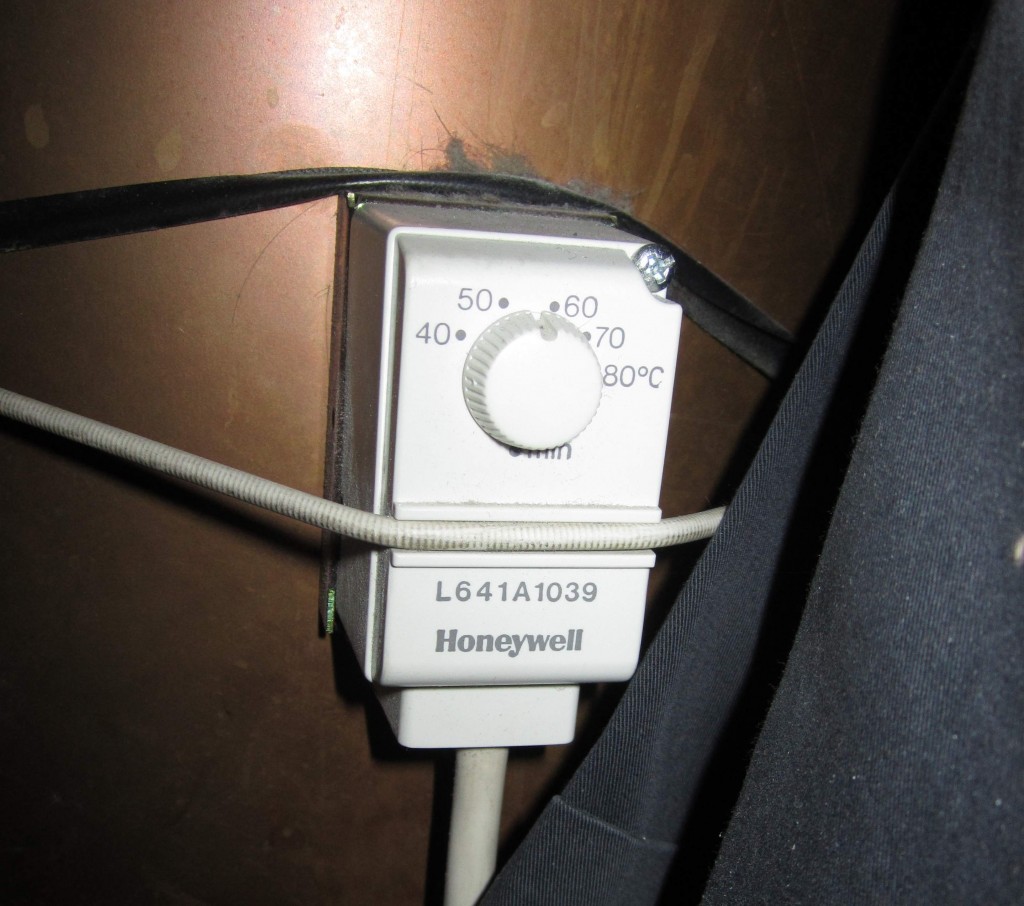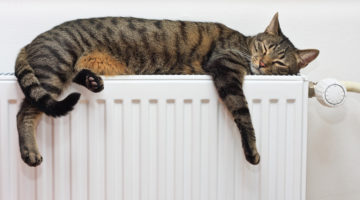
What are heating controls?
Heating controls allow you to easily regulate the temperature of your home. The controls automatically turn the heating on and off based on settings input by the user, to ensure maximum comfort. This process moves away from a fixed, traditional timer system and can therefore be used to better control the temperature within your home.
Thermostats, allowing people to control the temperature of their home, have been around for a long time. Newer heating control systems have evolved to the give residents total control of their heating, and by extension, their bills. The latest technology allows you to automatically control your heating to work around your daily schedule.
Products that make up a heating control system
There are four products that normally make up a full heating control system (based on a home with a traditional central heating system):
- A room thermostat
- A boiler programmer
- A hot water cylinder thermostat
- Thermostatic radiator valves
In our experience, many homes currently only have one or two of these.
Room thermostat
 Room thermostats take the temperature of the ambient air in the home and feed it back to the boiler to tell it to either fire up to raise the temperature of the home, or to turn off since the home is warm enough and no additional heating is required.
Room thermostats take the temperature of the ambient air in the home and feed it back to the boiler to tell it to either fire up to raise the temperature of the home, or to turn off since the home is warm enough and no additional heating is required.
They require free-flowing air so that the sensor can work out the right temperature. You’ll need to ensure that the thermostats are not blocked by household objects like curtains or furniture and avoid placing them near heat-emitting objects (fireplaces, radiators, household appliances etc). It is also recommended to house these in the lounge, since this is where homeowners typically spend most of their time. Having your thermostat in the hallway by your front door, for example, will not give an accurate reflection of the temperature of your home. This is because it’s an area commonly affected by draughts, when the front door is opened and closed.
Boiler programmers
 A boiler programmer is an automated way of turning the boiler on and off. People tend to like their homes to be warm when they wake up or come home from work. There seems little point in heating the home when no-one is there to get the benefit from the heat. A programmer allows you to set very specific time frames for when the heating comes on from day to day.
A boiler programmer is an automated way of turning the boiler on and off. People tend to like their homes to be warm when they wake up or come home from work. There seems little point in heating the home when no-one is there to get the benefit from the heat. A programmer allows you to set very specific time frames for when the heating comes on from day to day.
Let’s take the example of a family that go to school/work during the day. Typically the boiler would come on at approximately 6-7am to heat the house ready for when the family wakes up. This would then go off at about 9 when the people in the home leave for work or school. The boiler could then fire up again about 4pm in preparation for everyone coming home and go off just before everyone goes to bed.
These programmers allow you to set different heating patterns for each day, so if at the weekend more time is spent at home, you could use the programmer to reflect that.
The hot water cylinder thermostat
If you have an older boiler with a hot water tank, a hot water cylinder thermostat is a great way of ensuring the temperature of the water in the tank doesn’t get unnecessarily warm. Storing water at very high temperatures increases your bills, since you need to use more gas (or electricity if you use the immersion heater) to heat it. In addition, unless you’re a fan of a scalding hot shower or bath, you tend to add cold water to wash comfortably, which means you don’t need your water to be boiling in the first place.
The hot water cylinder thermostat is strapped to the hot water tank and has a dial on the front where you can adjust the temperature. Normally this temperature is set between 60 and 650c, which is hot enough to kill any bacteria but not so hot as to scold you when it comes out of the tap. It is a important to check the temperature of the thermostat on your hot water cylinder, since if it is set any higher than 650c, the chances are that you can turn it down and still get nice warm water, but save a bit on your gas bill at the same time.
If you don’t have a thermostat on your hot water cylinder it is certainly worth getting one fitted, since they cost less than £20 and can really help you to use less gas, but we do recommend getting a trained plumber to fit the thermostat.
Thermostatic radiator valves
 Using programmers and thermostats you can, in theory, dictate when you want the heating to come on and the temperature that you want it to be. Thermostatic radiator valves (TRVs) allow you additional control to further fine-tune your heating system.
Using programmers and thermostats you can, in theory, dictate when you want the heating to come on and the temperature that you want it to be. Thermostatic radiator valves (TRVs) allow you additional control to further fine-tune your heating system.
Much like the main thermostat, these TRVs track the temperature of the room in which the radiator is situated and will turn the radiator down (or off altogether) once it reaches the temperature chosen by you. TRVs allow the temperature of each room to be controlled individually from one another.
TRVs therefore really allow you to fine tune your heating system. For example, a room may have a lot of glazing and get warmer than the rest of your home when the sun is out. In this case, the thermostatic valve can shut off just that radiator, ensuring the occupant maximum comfort.
The future: intelligent heating systems
Heating optimisation works through an intelligent system that can help to save consumers additional money on their energy bills. Most people set their heating to come on at least an hour before they need it (in the mornings and evenings), but an intelligent heating system can sense the time it will take to heat the household to the required temperature, and turn heaters on automatically.
For example, a household might get up at 7am and want their home to be warm for this time. The traditional timer turns the heating on at 6am and works for an hour before everyone gets up. However on warmer days, the warmup time may be shorter than on cold days. An intelligent heating system will take this into consideration and set your boiler to fire up later, meaning less fuel will be used, resulting in savings in energy bills.
You might have a standard programmer that at most allows you to turn your heating on or off two or three times per day. An intelligent heating system can set multiple points where you set the time and temperature requirements for that day. The idea being that one may have different heating requirements for each day of the week.
Certain products on the market can have over 20 built-in plans, with further programmes available for customisation to an individual’s personal needs. For example, if you are a flexible worker, you can set customised patterns to suit your needs on different days. When you go on holiday, you can programme your heating not to come for the time you’re away.
In addition, these intelligent heating systems can be linked wirelessly to your phone or computer, so you can set the heating to come on as you are beginning your commute home. If you go away in cold weather, you can bring the heating on in your home even if you are not there to help prevent freezing.
Many of the intelligent heating features discussed above are now built into new heating control products available on the market today, and over the next few years they will become far more commonplace. All of the features work to more effectively regulate the temperature of your home, helping to minimise the amount of gas and electricity required to heat it.
The importance of heating controls
Installing huge quantities of loft or wall insulation will increase the energy efficiency of your property. However to get the biggest savings on your energy bills, it is absolutely key to be able to regulate the temperature of your home. Thermostats and TRVs are a really important way to help benefit from the increased energy efficiency of the envelope (floor, walls and roof) of your home. If you don’t have them, your boiler will continue to operate as it always has, which means your home will be warmer, but you will be using the same amount of gas.
It is also worth remembering that most of the features discussed will run behind the scenes in your home, so once you have set them up, you can then forget about them.
Finally – and this is one of our favourite tips – turning your thermostat just one degree can cut your energy bills by as much as 10%!
Benefits
- Heating controls allow you to accurately control the temperature of your house.
- They are relatively simple to set up, then they will run in the background and you can forget about them.
- Install a room thermostat if you didn’t have one before: this can save you approximately £70 and 280kg of carbon dioxide a year.
- You can also make savings by using your controls more effectively. Turn down your room thermostat by one degree to save around £65 and 230kg carbon dioxide a year.
Limitations
- Only the upfront cost of installing heating controls!
Cost
- Different suppliers offer different solutions but costs can start from £150 for a simple room thermostat to £1,000 for an integrated intelligence system that will combine both the room temperature regulation and programme-setting capabilities.













No Comments yet! Be the first one.